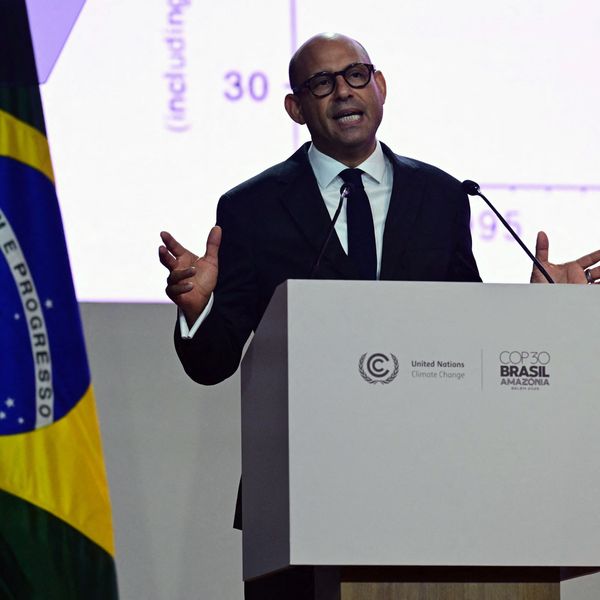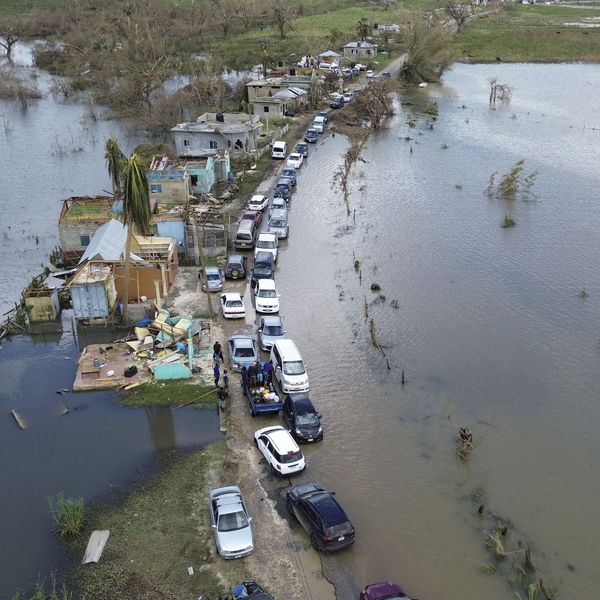The Global North-South Carbon Divide
Climate change talks must not be allowed to degenerate into a blame game: we need imaginative solutions for all economies
The global discussion on climate change has quickly degenerated into a north-south confrontation, for perhaps obvious reasons. On average, carbon emissions per capita in the developed world are about five times those in developing countries. Between some countries the differences are even starker: in 2006, the US per capita emission of tonnes of CO2 equivalent was 15.2, compared with 1.1 in India.
Obviously, the developed world has been and continues to be the basic cause of the problem. In the developing world the conclusion is obvious: rich nations must take on the basic burden of mitigation, consume less of the world's resources and reduce their contribution to global warming absolutely. That is why attempts to declare common goals of emission reduction across all countries are seen not only as unequal and unfair but even imperialist.
But the issue cannot be treated in simplistic terms. While they did not create the problem, the negative contribution of developing countries has been growing recently. Between 1980 and 2006, per capita carbon emissions declined slightly in developed countries (even the US), but they doubled in developing countries as a group, and nearly tripled in China. And the people of developing countries have a real stake in global action on this front, for they are already the worst affected by climate changes, as shown by the growing incidence of climatic shifts, especially in tropical and semi-tropical zones.
The problem is that the development project, in terms of ensuring basic needs to all the population, is still far from complete in many parts of the world - and certainly in India. Even without trying to replicate western standards of living, just to provide every citizen with the minimum decent standards of living that contemporary technology can offer, such as permanent housing, electrification, access to clean water, sanitation and sufficient food, will necessarily require more natural resource use and result in more carbon emissions.
To deal with this problem we need more imaginative responses in both north and south. First, GDP growth should not be an end in itself, since it is now widely recognised that it does not necessarily create more life satisfaction. It is not really clear why rich countries with falling populations need to increase their GDP, and why they should not focus instead on internal redistribution and changing lifestyles - which could in fact improve every citizen's quality of life.
Second, in the developing world, and especially in India, which is still a very low carbon emitter, there is now an opportunity to reorient growth in cleaner and greener directions: not just by changing energy sources at the margin, but also by emphasising cleaner and more public rather than private-based transport systems, better urban and regional planning and protecting and nurturing water and other natural resources. This also requires income distribution shifts and changes in socially created aspirations. This cannot be left to the market, because since the international demonstration effect and the power of advertising will continue to create undesirable wants and unsustainable consumption and production.
A dimension that is often missed is that CO2 emissions account for only about half of the global warming story. Ground-level ozone (from transport and biomass burning), black carbon (from motor vehicles) and methane production (from agriculture, cattle and wood burning) also play roles. And these are much easier to deal with in an overall growth framework using available technologies; indeed, reducing these should be an integral part of the development project because they are also human health hazards.
An Urgent Message From Our Co-Founder
Dear Common Dreams reader, The U.S. is on a fast track to authoritarianism like nothing I've ever seen. Meanwhile, corporate news outlets are utterly capitulating to Trump, twisting their coverage to avoid drawing his ire while lining up to stuff cash in his pockets. That's why I believe that Common Dreams is doing the best and most consequential reporting that we've ever done. Our small but mighty team is a progressive reporting powerhouse, covering the news every day that the corporate media never will. Our mission has always been simple: To inform. To inspire. And to ignite change for the common good. Now here's the key piece that I want all our readers to understand: None of this would be possible without your financial support. That's not just some fundraising cliche. It's the absolute and literal truth. We don't accept corporate advertising and never will. We don't have a paywall because we don't think people should be blocked from critical news based on their ability to pay. Everything we do is funded by the donations of readers like you. Will you donate now to help power the nonprofit, independent reporting of Common Dreams? Thank you for being a vital member of our community. Together, we can keep independent journalism alive when it’s needed most. - Craig Brown, Co-founder |
The global discussion on climate change has quickly degenerated into a north-south confrontation, for perhaps obvious reasons. On average, carbon emissions per capita in the developed world are about five times those in developing countries. Between some countries the differences are even starker: in 2006, the US per capita emission of tonnes of CO2 equivalent was 15.2, compared with 1.1 in India.
Obviously, the developed world has been and continues to be the basic cause of the problem. In the developing world the conclusion is obvious: rich nations must take on the basic burden of mitigation, consume less of the world's resources and reduce their contribution to global warming absolutely. That is why attempts to declare common goals of emission reduction across all countries are seen not only as unequal and unfair but even imperialist.
But the issue cannot be treated in simplistic terms. While they did not create the problem, the negative contribution of developing countries has been growing recently. Between 1980 and 2006, per capita carbon emissions declined slightly in developed countries (even the US), but they doubled in developing countries as a group, and nearly tripled in China. And the people of developing countries have a real stake in global action on this front, for they are already the worst affected by climate changes, as shown by the growing incidence of climatic shifts, especially in tropical and semi-tropical zones.
The problem is that the development project, in terms of ensuring basic needs to all the population, is still far from complete in many parts of the world - and certainly in India. Even without trying to replicate western standards of living, just to provide every citizen with the minimum decent standards of living that contemporary technology can offer, such as permanent housing, electrification, access to clean water, sanitation and sufficient food, will necessarily require more natural resource use and result in more carbon emissions.
To deal with this problem we need more imaginative responses in both north and south. First, GDP growth should not be an end in itself, since it is now widely recognised that it does not necessarily create more life satisfaction. It is not really clear why rich countries with falling populations need to increase their GDP, and why they should not focus instead on internal redistribution and changing lifestyles - which could in fact improve every citizen's quality of life.
Second, in the developing world, and especially in India, which is still a very low carbon emitter, there is now an opportunity to reorient growth in cleaner and greener directions: not just by changing energy sources at the margin, but also by emphasising cleaner and more public rather than private-based transport systems, better urban and regional planning and protecting and nurturing water and other natural resources. This also requires income distribution shifts and changes in socially created aspirations. This cannot be left to the market, because since the international demonstration effect and the power of advertising will continue to create undesirable wants and unsustainable consumption and production.
A dimension that is often missed is that CO2 emissions account for only about half of the global warming story. Ground-level ozone (from transport and biomass burning), black carbon (from motor vehicles) and methane production (from agriculture, cattle and wood burning) also play roles. And these are much easier to deal with in an overall growth framework using available technologies; indeed, reducing these should be an integral part of the development project because they are also human health hazards.
The global discussion on climate change has quickly degenerated into a north-south confrontation, for perhaps obvious reasons. On average, carbon emissions per capita in the developed world are about five times those in developing countries. Between some countries the differences are even starker: in 2006, the US per capita emission of tonnes of CO2 equivalent was 15.2, compared with 1.1 in India.
Obviously, the developed world has been and continues to be the basic cause of the problem. In the developing world the conclusion is obvious: rich nations must take on the basic burden of mitigation, consume less of the world's resources and reduce their contribution to global warming absolutely. That is why attempts to declare common goals of emission reduction across all countries are seen not only as unequal and unfair but even imperialist.
But the issue cannot be treated in simplistic terms. While they did not create the problem, the negative contribution of developing countries has been growing recently. Between 1980 and 2006, per capita carbon emissions declined slightly in developed countries (even the US), but they doubled in developing countries as a group, and nearly tripled in China. And the people of developing countries have a real stake in global action on this front, for they are already the worst affected by climate changes, as shown by the growing incidence of climatic shifts, especially in tropical and semi-tropical zones.
The problem is that the development project, in terms of ensuring basic needs to all the population, is still far from complete in many parts of the world - and certainly in India. Even without trying to replicate western standards of living, just to provide every citizen with the minimum decent standards of living that contemporary technology can offer, such as permanent housing, electrification, access to clean water, sanitation and sufficient food, will necessarily require more natural resource use and result in more carbon emissions.
To deal with this problem we need more imaginative responses in both north and south. First, GDP growth should not be an end in itself, since it is now widely recognised that it does not necessarily create more life satisfaction. It is not really clear why rich countries with falling populations need to increase their GDP, and why they should not focus instead on internal redistribution and changing lifestyles - which could in fact improve every citizen's quality of life.
Second, in the developing world, and especially in India, which is still a very low carbon emitter, there is now an opportunity to reorient growth in cleaner and greener directions: not just by changing energy sources at the margin, but also by emphasising cleaner and more public rather than private-based transport systems, better urban and regional planning and protecting and nurturing water and other natural resources. This also requires income distribution shifts and changes in socially created aspirations. This cannot be left to the market, because since the international demonstration effect and the power of advertising will continue to create undesirable wants and unsustainable consumption and production.
A dimension that is often missed is that CO2 emissions account for only about half of the global warming story. Ground-level ozone (from transport and biomass burning), black carbon (from motor vehicles) and methane production (from agriculture, cattle and wood burning) also play roles. And these are much easier to deal with in an overall growth framework using available technologies; indeed, reducing these should be an integral part of the development project because they are also human health hazards.

